7 Tap, Jazz, Musical Theater, Television and Film
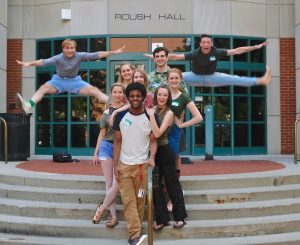
The development of jazz and tap dance forms resulted from West African dance forms that were eventually blended with other cultures, beginning with the transatlantic slave trade in the mid-late 16th century. While slaves were transported to what we now know as the United States, the ship’s captains wanted to keep their cargo healthy. The enslaved people were brought on top of the ship to actively perform what was called “dancing the slaves.” They stayed shackled; however, they came up with creative ways to exercise and mimicked the percussive sounds derived from drums that were an integral part of their culture. The Africans used their bodies to maintain some of these sounds and rhythms, such as hambone. From African, Spanish, Irish, and other cultural dance roots, tap and jazz dance forms were unstructured, and over time, became structured forms of dance that have blended and evolved over the years. The American inventions of tap and jazz were built from African drumming rhythms mixed with other forms of dance cultures and rhythms. It is important to note that jazz dance, tap dance, and jazz music are the only forms of dance and music created in the United States by our enslaved African ancestors.
As the country changed, adding immigrants from Europe, the Middle East, the Caribbean, South America and Africa, social dances absorbed all these flavors and produced exciting new forms. Minstrel shows of the early 1800s were replaced by Vaudeville shows after the Civil War. Post World War I, ragtime music was disappearing into jazz. Shows began incorporating jazz and swing music which called for a new style of dancing. These shows, in turn, were replaced or supplemented by Broadway and Hollywood musicals and eventually movies and television. In this chapter, we will look at how the dance forms continue to evolve in television, film, and music videos.
“Sometimes dancing and music can describe a true image of the customs of a country better than words in a newspaper. – Gene Kelly
TAP
TAP DANCE CHARACTERISTICS
- Dancers wear shoes that can be either flat-soled or heeled, usually with metal ‘taps’ attached, which strike the floor to make [pb_glossary id="165"]percussive[/pb_glossary] sounds. Each part of the shoe makes a particular beat and sound.
- Dance steps use quick polyrhythmic and syncopated sounds.
- Dancers often use improvisation to create their own rhythms.
- Some sub-styles include hoofing, soft shoe, flash act, Broadway tap, and rhythm tap.
When enslaved people were forbidden to play percussion instruments by plantation owners fearing an uprising, they found other ways to communicate and keep their culture alive, mainly by slapping their thighs, clapping hands, jawboning, stomping or tapping rhythms with their feet. The Juba dance or hambone, originally known as Pattin’ Juba, is an African-American style of dance that involves stomping as well as slapping and patting the arms, legs, chest, and cheeks. “Pattin’ Juba” would be used to keep time for other dances during a walkaround, using tin cans under their feet as well as beating on bowls with spoons. Eventually these dances merged with the clogging and jigs brought by Irish indentured servants to form American Tap. Early tap dancers wore hard soled or wooden shoes. If they wore a soft soled shoe, they attached pennies, nails or pieces of metal to the toes and heels to enhance the sound. Some young dancers in America today still attach bottle caps or tin cans to their shoes to create an inexpensive tap shoe.
Watch This
This is a video of kids in homemade tap shoes dancing in the New Orleans French Quarter.
In the early 1830s, minstrel shows became popular and toured the land. Performances included songs, dance, variety acts, and jokes that came at the expense of African Americans, as white men in blackface appropriated Black culture by inappropriately mimicking and mischaracterizing African Americans. For instance, the cakewalk was a popular dance tradition for slaves on plantations in the 19th century that was adopted by white performers and presented in minstrel shows. The cakewalk was performed as a competitive dance performed on plantations. In essence, the cakewalk was an exaggerated parody created by the slaves to imitate the upper-class mannerisms of their white plantation owners—the main movement and steps derived from European dances, such as the minuet.
Watch This
The Cakewalk
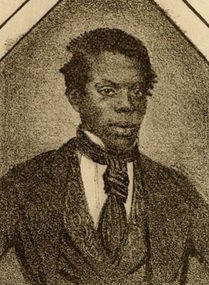
William Henry Lane, also known as Master Juba, was born a free African American in 1825. He grew up learning to dance from “Uncle” Jim Lowe, an African American jig-and-reel dancer. At a young age, Lane became well-known for his talent. Master Juba is considered the first to perform as an American tap dancer. His style combines Irish reel steps, clogging with African rhythms. Eventually, white performers were replaced by African American performers. Master Juba was featured in minstrel shows as the best dancer in America.
Watch This
The history of Master Juba.
In the 1870’s vaudeville began to replace minstrel shows, and for the next sixty years vaudeville ruled the day. Touring groups crisscrossed the land bringing shows to the masses with wholesome entertainment that ladies and children could attend. These were variety shows. Acts ranged from dance to acrobats, jugglers to child performers, and comedy acts to kick lines of chorus ladies. Tap dance found an audience in vaudeville and its performance flourished.
Bill “Bojangles” Robinson (1878-1949)

Bill “Bojangles” Robinson (1878-1949) began his dancing career in vaudeville. He gained fame and popularity in the movies in which he acted, sang and danced. He appeared in a number of movies with the young actress Shirley Temple and was the first to break the color barrier which had prevented mixed races from performing together. He also appeared with Lena Horne, Cab Calloway, and Katherine Dunham in Stormy Weather. He became the most popular and highest paid African American performer of his time. In spite of this, he died penniless and alone. After his death, his birthday, May 25, became National Tap Dance Day in his honor.
Watch This
Bill Robinson: Performing his famous “Stair Dance” with Shirley Temple in “The Little Colonel”, 1935
John W. Bubbles (1902-1986)

John W. Bubbles is considered the “Father of Rhythm Tap.” Bubbles used heel drops to accent the offbeat parts of the music. He was also known for his impressive improvisational skills. Bubbles also performed with Ford Lee “Buck” Washington in Vaudeville shows and received acclaim for their talents.
Watch This
John W. Bubbles perform.
Charles “Honi” Coles (1911 – 1992)

American tap dancer and actor Charles “Honi” Coles and his longtime partner, Charles “Cholly” Atkins popularized tap dance enormously. They toured with Duke Ellington’s, Cab Calloway’s & Count Basie’s big bands while making short films for TV. Honi Coles earned a Tony Award in 1983 for his Broadway dancing and a National Medal for his dancing contribution. He taught dance and dance history at universities including Cornell, George Washington, Yale, and Duke in the 1980s.
Watch This
Charles “Honi” Coles
The Nicholas Brothers
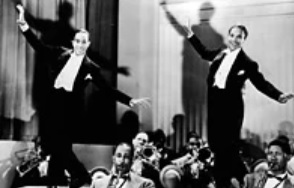
Fayard Nicholas (1914-2006) and Harold Nicholas (1921-2001) At a very young age, the Nicholas brothers were introduced to dance while watching the vaudeville acts for which their parents played in the orchestra. They learned to be dancers, singers, and actors. Because they were so versatile, their career extended to vaudeville, movies, nightclubs, concerts, Broadway, records, radio, and television. They performed a very acrobatic style of tap that has been called “flash” tapping which included backflips and jump splits. Unlike many Black performers of this period, they refused to wear service uniforms and almost always appeared in the formal wear of white tie and tails.
Fred Astaire (1899-1987)
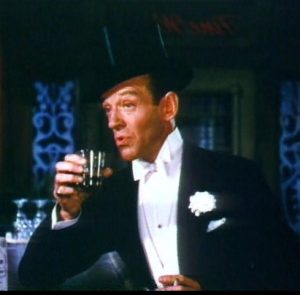
Fred Astaire (1899-1987) was famous for combining tap with ballroom dance, creating an elegant, easy going style of rhythmic tap. He had many different partners including Ginger Rogers, his most renowned partner. Astaire was known for surprising tricks such as dancing up a wall or ceiling, dancing with a coat rack or a mop, and dancing to firecrackers. He revolutionized how dance scenes were filmed, insisting that his dances be filmed with a single take and wide camera angle, instead of using cutaways and close ups and multiple takes. This became the norm for recording tap dancing in movies and television for decades. He will be discussed further in the Musical Theater section.
Watch This
Fred Astaire in “Say It With Firecrackers” from Holiday Inn (1942)
Gene Kelly (1912-1996)
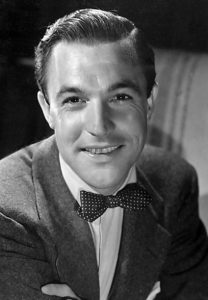
Gene Kelly is known for his athleticism, acrobatic abilities, charm, and insistence on perfection. He also combined tap, ballroom, and ballet in his dancing. One of the most famous tap dance sequences known today is in the movie Singin’ in the Rain. Gene Kelly also directed several films where he experimented with lighting, camera techniques, and special effects to achieve proper integration of dance with film and was one of the first to use split screens, double images, and live-action with animation.
Watch This
Gene Kelly Singing in the Rain, 1952
Contextual Connections
Other Notable Tap Dancers and Performances
Ruby Keeler (1910-1993)
American actress, dancer, and singer Ethel Ruby Keeler was known for her partnership with Dick Powell in several successful musicals at Warner Bros., particularly 42nd Street.
Eleanor Powell (1919-1982)
Eleanor Powell initially performed in nightclubs as one of the few female tap dance soloists of the time. By the 1930s, Powell became a well-known tap dancer in Hollywood musicals as one of the top tap dancing stars. She became known for quick and complex footwork and acrobatic abilities.
Ginger Rogers (1911-1995)
American actress, dancer, and singer Ginger Rogers was famous in early Hollywood. She was a favorite partner of Fred Astaire in the RKO musicals. Her starring role in Kitty Foyle (1940) Rogers won an Academy Award for Best Actress.
Gregory Hines (1946-2003)
Hines was one of the most celebrated tap dancers of all time, famous for being an improviser of tap steps, sounds, and rhythms. His improvisation was compared to that of a drummer, doing a solo and coming up with exciting beats. Hines appeared on Broadway and starred in more than forty films. In addition to numerous accolades, Gregory Hines won a Daytime Emmy Award, a Drama Desk Award, and a Tony Award.
Savion Glover (1973-)

Savion Glover is an exciting tapper who studied with Gregory Hines and found great success as a dancer. He choreographed and performed in Bring in ‘Da Noise, Bring in ‘Da Funk, a 1996 Broadway show that is a history of the black experience told in rap. He won a Tony award for that choreography. Glover stated that his style is funk tap. When asked to describe what funk is, he says it is the bass line. “Funk is anything that gets one’s head on beat. It is riding with the rhythm. It is a pulse that keeps one rolling with the beat.” Gregory Hines stated that “Savion is possibly the best tap dancer that ever lived.” Savion Glover is a contemporary hoofer; he states that tap dance is a dance style, while hoofing is a lifestyle.
Watch This
Savion Glover Bring in ‘da Noise.
Chloe Arnold (1980-)

Director, producer, Emmy-nominated choreographer, and actress Chloe Arnold is recognized globally for her tap dancing. Her company won the 1st Crew Battle on Fox’s program, So You Think You Can Dance. Together with her sister Maud Arnold, Chloe co-directs and produces DC Tap Festival, a critically acclaimed and worldwide recognized festival. The US House of Representatives has acknowledged them as art ambassadors and preservers. As a solo tap dancer, Chloe has delivered performances in more than 21 countries and 35 states.
Watch This
Chloe Arnold
Maud Arnold (19 )
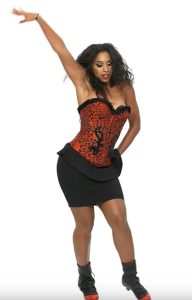
Maud, the sister of Chloe Arnold, is a tap sensation. She has quickly established herself as a desired performer, teacher, and judge in various geographical locations, including the U.S., Brazil, Russia, Tokyo, and Barcelona. Maud has collaborated with Beyoncé and was featured in the national commercial of Toyota Corolla in 2014. Maud and her sister Chloe founded the Syncopated Ladies to raise female status in a male-dominated tap world. After releasing their first video in 2012, the Syncopated Ladies have become iconic for tap dancing to pop music and hip-hop.
Watch This
Maud Arnold
Chloe and her sister Maud, founded the Syncopated Ladies to raise female status in a male-dominated tap world. After releasing their first video in 2012, the Syncopated Ladies have become iconic for tap dancing to pop music and hip-hop.
Watch This
Syncopated ladies
Dormeshia Sumbry-Edwards (1976- )
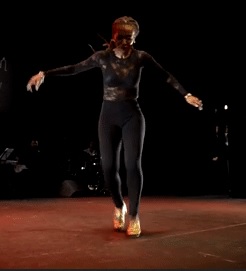
Dormeshia Sumbry-Edwards (1976- ) began dancing at the age of 3 and earned recognition as a tap dance prodigy by 12, appearing in Broadway productions, performing with legendary tap dancers Gregory Hines, Jimmy Slyde, Buster Brown, and Savion Glover. Dormeshia is referred to as the “queen” by the New York Times and “the mastress of her generation.”
Watch This
Dormeshia perform at the Stockholm Dance Tap Festival
Ayodele Casel (1975- )
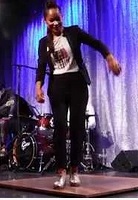
Ayodele Casel combines tap dancing with inspiration from salsa music. She was the only woman in Savion Glover’s company, Not Your Ordinary Tappers. Casel choreographs for Broadway shows, such as the 2022 revival of “Funny Girl.” She co-directs Operation Tap, an online educational platform. In 2021, she was featured on the US Postal Service Forever Stamp.
Watch This
an excerpt from Chasing Magic.
Michelle Dorrance (1979-)
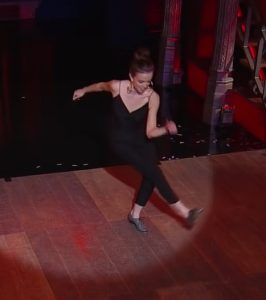
Michelle Dorrance founded Dorrance Dance in 2011. Dorrance received wide attention for keeping the traditions of tap dance while expanding the art form’s boundaries. In 2015, Dorrance received the MacArthur Fellowship for her creative contributions to tap dance and for educating people about tap dance history.
Watch This
JAZZ
JAZZ DANCE CHARACTERISTICS
Jazz dance often contains elements of social dance, but in a performance manner.
Dancers use isolations, accentuating one specific part of the body, such as the head, rib cage, or hip.
Dancers keep a low center of gravity, and often bend their knees for more freedom of movement.
Percussive or syncopated movements are used to accent offbeats or surprising aspects of the music.
Sensuality in jazz dance is emphasized more than in traditional styles.
During the Vaudeville era, New Orleans’ Congo Square became a pivotal location where various cultures came together and shared their customs and traditions through music, song, and dance. The exchange of cultural elements brought about jazz music combining blues and ragtime. It incorporates polyrhythms, polycentrism, syncopation, and improvisation that dance mirrored as it developed alongside jazz music. During the 1940s, when bebop music was introduced, jazz dance branched out to use other music genres.
As Hollywood became the new ground for entertainment, jazz dance forms and music continued to evolve in jazz clubs. The Harlem Renaissance (1921-1933) was the cultural movement highlighting African-American artists, authors, and philosophers in New York. Jazz clubs, such as the Cotton Club and Apollo Ballroom, promoted African-American jazz musicians and dancers that attracted a broad audience, gaining widespread attention to jazz.
As we saw in the Modern Dance section, Katherine Dunham is known as the Matriarch of Black Dance. Dunham integrated the syncopated rhythms of Haiti, Cuba, Brazil, and the Caribbean into American dance. She is credited with the technique of body isolationism and incorporating it into her dance style. Katherine Dunham’s influence and dance technique had a huge impact on the world of jazz dance. Today almost all jazz dancers use her technique in their dance.
Josephine Baker (1906-1975)
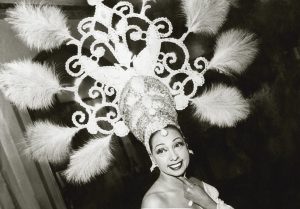
American-born Josephine Baker was a dancer, singer, and actress who centered her career in Europe, mainly in France. Siren of the Tropics (1927), directed by Mario Nalpas and Henri Étiévant, gave her the distinction of breaking the color barrier and being the first African American woman to star in a major motion picture.
Watch This
Jack Cole (1911-1974)

Jack Cole has been called the “father of American jazz dance.” He made his professional dance debut with Denishawn in August 1930. Cole was influenced by the pioneering modernists Doris Humphrey and Charles Weidman, with whom he performed briefly. His career spanned three significant arenas: nightclub, Broadway stage, and Hollywood film. He was a pioneer for multiculturalism in the musical comedy dance arena. Cole’s style of dancing is innovative, acrobatic, and angular. He is known for using small groups of dancers rather than a large company. Jack Cole is remembered as the prime innovator of the theatrical jazz dance heritage.
WATCH Jack Cole choreography https://youtu.be/bd_tuhzvsD8
Watch This
Jack Cole choreography
Bob Fosse (1927-1987)
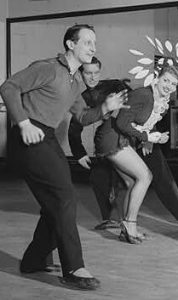
Robert Louis Fosse followed in the footsteps of Jack Cole in his work on Broadway. Fosse was an American actor, choreographer, dancer, director and screenwriter.
He was a prolific director and choreographer, creating musical works on stage and screen, including the stage musicals Damn Yankees (1955) and Chicago (1975). His films include Cabaret (1972) and All That Jazz (1979). Fosse’s distinctive style of choreography was known for “jazz hands” and slouched turned-in positions. In 1973 he won an Oscar, Emmy, and Tony awards all in the same year. Fosse won a record eight Tonys and was nominated for several Academy Awards. He won Best Director for Cabaret and the Palme D’Or in 1980 for All That Jazz. He also won an Academy Award for direction for Pippin.
Watch This
Bob Fosse and wife Gwen Verdon Who’s Got the Pain
Gwen Verdon (1925-2000)
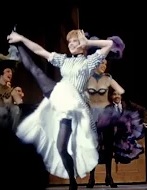
American actress and dancer Gwyneth Evelyn “Gwen” Verdon was an accomplished performer on Broadway and Hollywood. Not only did she win four Tony Awards for her musical comedy performances, but she also served as an uncredited choreographer’s assistant and specialty dance coach for theater and film.
Watch This
Carmen de Lavallade (1931-)

Carmen de Lavallade, a native of New Orleans, worked with Lester Horton and Alvin Ailey to create her signature style of jazz dance. She was a member of the Lester Horton Dance Theater in 1949, where she danced as a lead dancer until her departure for New York City with Alvin Ailey in 1954 and made her Broadway debut with Alvin Ailey in the musical House of Flowers. She staged musicals, plays, and operas and eventually became a professor and member of the Yale Repertory Theater. In December 2017, she received the Kennedy Center Honors Award.
WATCH Carmen de Lavallade Dear Quincy 1968 https://www.youtube.com/watch?v=EJuydDuAGHM
Watch This
Joe Tremaine (1938-)
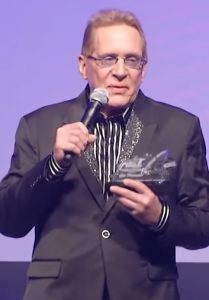
Joe Tremaine, a native of New Orleans, studied with many of the great dancers of the 1960s. Having appeared in many films and Broadway shows, Tremaine was later cast by June Taylor as one of the eight male dancers on the Jackie Gleason Show. He later became known as the dance teacher of the stars, working with such names as Diana Ross, Goldie Hawn, Barry Manilow, and Cameron Diaz.
Watch This
Ann Reinking (1949-2020)
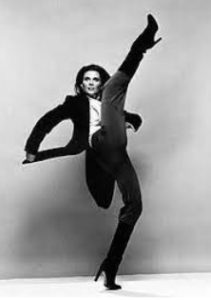
American dancer, actress, choreographer, and singer Ann Reinking was Bob Fosse’s lead dancer and wife in the 1970s. She worked extensively in musical theater. Reinking starred in Broadway productions such as Coco, Over Here!, Goodtime Charley, Chicago, Dancin’, and Sweet Charity.
Watch This
Debbie Allen (1950-)
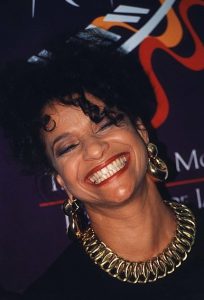
Deborah Kaye Allen is a popular American actress, dancer, choreographer, director, and producer. She has won five Tony Awards, a Golden Globe Award, and has a star on the Hollywood Walk of Fame. Her choreography in the television series Fame (1982-1987), where she portrayed dance teacher Lydia Grant made her famous. Allen has directed more than 50 television and film productions. One of Allen’s notable productions is the Hot Chocolate Nutcracker, a huge success for over 12 years.
Watch This
Codified Jazz Dance Technique
During the Integration of Concept Musicals, technically trained dancers became favored to convey the storyline. To meet the demands required in the choreography, jazz dancers began forming techniques. These techniques became the basis of studio training for dancers.
Eugene Louis Faccuito “Luigi” (1925-2015)
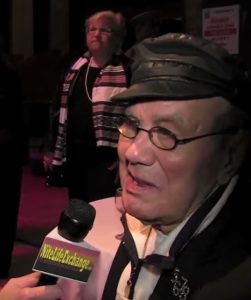
As an adult, Eugene Louis Faccuito, nicknamed “Luigi,” was paralyzed on the right side of the body following a car accident. Doctors were convinced he’d never walk again; however, Luigi was unwilling to accept this and created a warm-up of set exercises that helped him recover from paralysis. The warm-up included classical ballet principles combined with parallel body positions and isolations to encourage the body muscles to activate and build strength appropriately. In 1956, Luigi founded the First World Jazz Centre, where students trained in his techniques.
Watch This
Luigi dance technique
Matt Mattox (1921-2013)
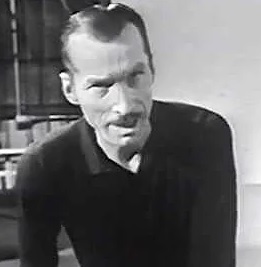
Matt Mattox developed a technique called freestyle. Freestyle is a technique that builds upon levels from beginner to advanced, combining ballet with polyrhythmic body isolations and the complex footwork often used in tap dance.
Watch This
Matt Mattox dance technique
Gus Giordano (1930-2008)
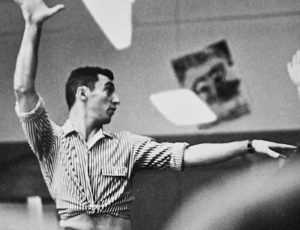
Gus Giordano used modern dance components in his technique, such as contractions, hinges, and parallel leg positions to develop muscular strength. The Giordano Dance Center in the Chicago area was established in 1953 to elevate the appreciation of the dance form and provide dancers training in Jazz. Later, he founded the Gus Giordano Jazz Dance Chicago to bring jazz dance to the concert stage. In 1990, Giordano established the Jazz Dance World Congress as an annual event that brought together master teachers, choreographers, and professional jazz dance companies worldwide for classes and performances.
Watch This
Gus Giordano Steam Heat
Lynn Simonson (1943-)
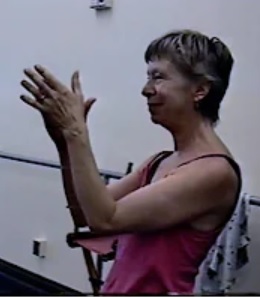
Lynn Simonson created the famed Simonson Jazz Technique. Taught in 16 countries, Simonson Jazz Technique trains dancers regardless of their style. Her method is the official one taught at Manhattan’s DanceSpace. Simonson’s jazz technique uses anatomical awareness to help dancers move efficiently and easily to reduce injuries.
Watch This
Lynn Simonson teaching a dance class
JAZZ DANCE TODAY
Today, jazz dance includes a wide range of styles that branched from communal experiences of authentic jazz/social dances to gain global attention. Jazz dance mirrors societal trends, resulting in various jazz dance styles, including theatrical, lyrical, and commercial dance.
Pat Taylor
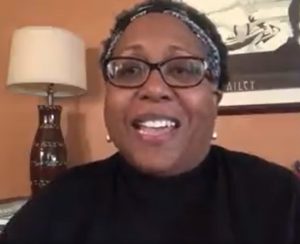
In 1993, Pat Taylor founded JazzAntiqua Dance & Music Ensemble, celebrating African American jazz history and traditions. The company is dedicated to educating, preserving, and creating an appreciation of jazz by collaborating with artists in performances, classes, and community events.
WATCH JazzAntiqua Dance & Music Ensemble
Brian Swartz & the Gnu Sextet
Choreography: Pat Taylor, Artistic Director
Watch This
JazzAntiqua Dance & Music Ensemble Brian Swartz & the Gnu Sextet Choreography: Pat Taylor, Artistic Director
Melanie George
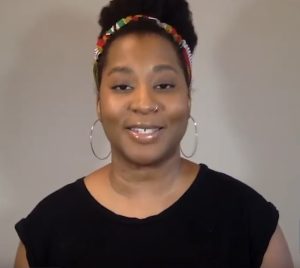
In 2012 Melanie George founded the Jazz is… Dance Project, showcasing a form she calls Neo-Jazz, characterized by early jazz dance styles and aesthetics combined with contemporary jazz techniques. George centers her movements on West African elements, based on eight key elements noted on her website, https://www.melaniegeorge.org/neo-jazz: Groundedness and weight sensing; Rhythm and syncopation; Isolations; Weight shift from the pelvis to facilitate complex footwork; Musicality and a deep relationship to jazz music, and its related forms – blues and funk; Improvisation; A Black American vernacular base for movement vocabulary and composition; Acknowledgement of community, while honoring the individual.
MUSICAL THEATER
MUSICAL THEATER CHARACTERISTICS
The choreography furthers the storyline of a musical production and helps in character development.
The movements are often exaggerated to reach the audience in large theaters.
Many styles of dance can be utilized depending on the music and lyrics.
The dancing often showcases athleticism or unusual stunts.
Musical Theater dance grew out of Vaudeville shows when directors began stringing songs, dances, and skits into a loose storyline. It took off in the 1940’s with Jack Cole’s fusion of jazz, ballet, and various global dance forms combined in the musical Something for the Boys. It has gone through many changes in popularity and styles, but remains popular today whether performed live on stage, on film, or on television. Musical Theater dance embodies the collaboration between choreographers and writers as it combines choreography and written text, and sung lyrics. It is less of a single dance style and more of a purpose for which dance is used in a musical production.
Here are a few of the important musical theater works:
Shuffle Along, 1921, music composed by Eubie Blake, lyrics by Noble Sissle, was written, staged, and performed in 1921 entirely by African Americans, Shuffle Along was the first show to make African-American dance an integral part of American musical theater. The African-American musicals of this era, especially Shuffle Along, are of great importance to the history of American musical theater.
Watch This
Shuffle Along historical overview
- In Oklahoma!, 1943, was the first musical written by the duo of Rodgers and Hammerstein. Dance sequences are incorporated into the plot of the show. In this dream scene, the heroine dreams about her romantic choices and their possible outcomes. WATCH Oklahoma!: Rogers and Hammerstein, choreographer: Agnes DeMille https://youtu.be/2D1loAVwiMc
- West Side Story, 1957, is a concept musical choreographed by Jerome Robbins that is a modernized adaptation of William Shakespeare’s Romeo and Juliet, highlighting the tension of rival street gangs. It was translated to film in 1961 and again in 2021.Watch the trailer for the 2021 version directed by Steven Spielberg. https://youtu.be/A5GJLwWiYSg
- Mary Poppins, 1964, is a movie musical choreographed by Louisiana native Marc Breaux and his wife Dee Dee Woods. The musical is about a magical nanny who arrives to care for the children of a busy banker and his Suffragette wife. The original movie stars Julie Andrews and Dick Van Dyke. This video shows the energetic chimney sweep dance “Step in Time.” https://youtu.be/YSCdFVc6DoY
- The 1966 musical Cabaret, with music by John Kander, lyrics by Fred Ebb, and book by Joe Masteroff, is set in 1929–1930 Berlin during the Jazz Age as the Nazis are coming into authority. The musical unfolds in the decadent nightlife scene at the seedy Kit Kat Klub and revolves around American writer Clifford Bradshaw’s relations with English cabaret performer Sally Bowles. This video from the movie version, 1972, shows the title song and dance. https://youtu.be/hBlB8RAJEEc
- A Chorus Line, 1975, looks at a Broadway dance audition. The dancers share revelations about the life of a gypsy, a Broadway dancer. It was unusual in that it showed the behind-the-scenes view of auditioning and developing a Broadway show. In 1985, it was adapted to film. WATCH A Chorus Line: “One” (Finale) from the movie with choreography by Michael Bennett.https://youtu.be/tyZeGOsR9IA
- Chicago, 1975, is a satire on the concept of the “celebrity criminal” set in the 1920s Jazz Age. It features the stories of women who murdered husbands and lovers and the slick lawyer who manipulates the media and the court to win their freedom. WATCH All That Jazz from Chicago. Choreography by Bob Fosse. https://youtu.be/MnQKqtWT6nM
- Cats, opened in London in 1981 and opened on Broadway in 1982. It is a musical composed by Andrew Lloyd Webber, based on the 1939 poetry collection Old Possum’s Book of Practical Cats by T. S. Eliot. It tells the story of a tribe of cats called the Jellicles and the night they make the “Jellicle choice” by deciding which cat will ascend to the Heaviside layer and come back to a new life. The choreography is by Gillian Lynne and brilliantly imitates the movement and attitude of cats. https://youtu.be/GbpP3Sxp-1U
- The Lion King, 1997, unlike most musicals, began as a Disney Studios animated film in 1994. Directed by sculptor and puppeteer Julie Taymor, the musical features actors in animal costumes as well as giant, hollow puppets worn and operated by the actors and dancers. Directed by sculptor and puppeteer Julie Taymor, the musical features actors in animal costumes as well as giant, hollow puppets worn and operated by the actors and dancers. The music is by Elton John, along with additional music and lyrics by Lebo M, Mark Mancina, Jay Rifkin, Julie Taymor, and Hans Zimmer. Watch this promotional video from Disney on Broadway. https://youtu.be/SjUG0M54dQc
- Bring in ‘Da Noise, Bring in ‘Da Funk (1996) Tap legend Savion Glover created the Tony Award-winning “Bring In ‘Da Noise, Bring In ‘Da Funk” with a mission—to break down the stereotypes of what tap dance could be.Watch this video which shows the Taxi Dance that grew out of Glover’s experience of being ignored by cabs when he was trying to get to rehearsal.. https://www.youtube.com/watch?v=IxlNOvMvLJA&t=7s
- The Producers, 2001, is a musical with music and lyrics by Mel Brooks, book by Brooks and Thomas Meehan and choreography by Susan Stroman. It is adapted from Brooks’s 1967 film of the same name. The story concerns a failing theatrical producer and his accountant who scheme to produce the most notorious flop in history, thereby cheating their backers out of millions of dollars. Unfortunately, the show is a hit. Mel Brooks draws on ridiculous accents, caricatures of Nazis, and many show business in-jokes. Watch this trailer for the Broadway show. https://youtu.be/VYwOcQ-c6f0
- Hairspray, 2002, is an American musical that follows teenage Tracy Turnblad’s journey as she tries to dance on The Corny Collins Show, choreographed originally by Jerry Mitchell. The show’s energy comes from the 1960s-style dance music and “downtown” rhythm and blues. It is based on John Waters’s 1988 film of the same name. The video features a rousing song and dance to “You Can’t Stop the Beat.” https://youtu.be/9VFw5pD3Z_8
- Hamilton, 2015, choreographed by Andy Blankenbuehler, is a groundbreaking rap musical that tells the story of Alexander Hamilton. Written by and starring Lin-Manuel Miranda, the show was sold out on Broadway far into the future before pandemic closings forced an end to the show. Fortunately, a performance was filmed in 2016 and is now available to watch on Disney Plus. Watch the official clip compilation for Hamilton, a musical movie starring Lin-Manuel Miranda and Phillipa Soo. https://youtu.be/DSCKfXpAGHc
Assessement: Test your knowledge on tap, jazz, and musical theater.
FILM AND TELEVISION
“Film and television have greatly expanded the dance audience and led to the new art form of dance films, while video and computer technology are aiding in dance creation, preservation, education and marketing.” Feb 2, 2011 https://www.thecanadianencyclopedia.ca ›
Watch This
Many of the popular Broadway or Off-Broadway musicals made the transition into the movies and eventually into television. MGM (Metro Goldwyn Mayer) produced hundreds of movie musicals throughout the 1930’s , 40’s, and 50’s. Performers like Fred Astaire and Gene Kelly were under contract to the film studio. Movies like Singin’ in the Rain and Seven Brides for Seven Brothers, had high production values and were tremendous box office hits.
Here are a few musicals that were made for film:
Stormy Weather, the 1943 movie features the choreography of Katherine Dunham. It was filmed with an all Black cast and tells the story of an ambitious song and dance man played by Bill Robinson and his on and off relationship with a beautiful singer played by Lena Horne. In this excerpt, Ms. Dunham and her dancers embody the storm, a metaphor for a stormy relationship.
Watch this
Royal Wedding, 1951, shows a clever innovation created by Fred Astaire in which the set rotates to create the illusion of dancing up the walls and on the ceiling.
Examples
Singin’ in the Rain, 1952, starring Gene Kelly, Debbie Reynolds, and Donald O’Connor was hugely popular. It was a film about film history and the mishaps of the transition to sound for both actors and technicians. This excerpt features Gene Kelly in the title song.
Examples
White Nights, 1985, stars ballet dancer Mikhail Baryshnikov and tapper Gregory Hines and was choreographed by Twyla Tharp. In this movie the Russian ballet dancer who wants to defect to America meets an American tap dancer who defected to Russia to avoid serving in the Vietnam war. Together they plot ways to defect back to the United States while competing with their dance forms.
Examples
Assessment: Chapter review.
SUMMARY
Tap dance evolved out of a need when African percussion instruments were taken away from slaves; slaves then turned to their bodies as percussive instruments to express themselves and retain their cultural identities. Jazz dance evolved out of an extension of African movements of isolation, syncopation, and polyrhythmic movements to interpret the sounds of Jazz music as an accompaniment. Tap and Jazz dance are currently performance styles that were birthed in the United States in the early 19th century and mid 20th century respectively. African and African descendants were at the heart of the unique dance forms that were created in the US. They met at the crossroads of Irish, Spanish, and French dance and music forms. Musical Theater evolved out of Vaudeville shows which involved singing, dance, music, and scripts with storylines. Musical Theater is not a dance style, but a vehicle for which dance is used with songs to enhance the storyline in the written text. Television and film have given dance more worldwide attention. With today’s computer technology outlets, dance remains viable and essential.
Check Your Understanding
1. Try dancing along with the lesson in this video: https://youtu.be/y60nqyhwYoM . Make up your own rhythm pattern using the basic moves you learned. Which elements of dance did you use?
2. Select two videos from this chapter, one from the early days and one from modern times. Compare and contrast them using dance vocabulary
3. Chapter 5 Quiz.
refers to attack-like quality to produce sharp, sudden, and abrupt movements
The hambone was originally known as Pattin' Juba, hambone is an African-American style of dance that involves stomping as well as various types of body percussion.
Jazz dance is a performance dance style that arose in the United States in the mid 20th century. Jazz dance had its roots in African dance and can refer to social dance forms of jazz as well as Broadway or dramatic jazz.
Tap is a dance form that is performed wearing shoes fitted with metal taps, characterized by rhythmical tapping of the toes and heels.
a polyrhythm refers to two or more rhythms within a tempo. Polyrhythmic patterns are featured in African dance, music, and drumming.
Syncopation is the accenting of a note which would usually not be accented. It is often described as being off beat. The time signature of a piece of music has a regular pattern of strong and weak beats. A syncopated rhythm goes against this pattern by putting the accent on weak beats.
Hoofing means dancing into the floor with emphasis placed on stomps and stamps in addition to rhythmic percussion of the sounds, music, and syncopations. Gregory Hines made this style of tap popular.
Soft shoe is a form of tap dancing that does not require special shoes. Rhythms can be made by tapping of the feet or sliding the feet, sometimes using scattered sand on the stage to enhance the sound. Clayton “Peg Leg” Bates made this style popular although Minstrel George H. Primrose began doing this style in his shows.
Sometimes called swing tap or classical tap, flash tap consists of a combination of jazz dance and acrobatics. The Nicholas Brothers were great examples of this style.
This style combines both traditional tap dancing with musical theater style dancing. There is an emphasis on using the upper body and arms, not just the feet. Gene Kelly and Fred Astaire exemplified this style.
In rhythm tap the shoes themselves are instruments.Sounds are made by striking the heel, toe, or whole foot. It is often performed with no musical accompaniment. John W. Bubbles was known for this tap style.
This was a show which included songs, dance, variety acts, and jokes that came at the expense of African Americans, as white men in blackface appropriated Black culture by inappropriately mimicking and mischaracterizing African Americans. It developed in the US in the early and mid 19th century and was widely performed until the mid 20th century but is now regarded as highly offensive.
The cakewalk was a pre-Civil War dance originally performed by slaves on as a competitive dance. It was an exaggerated parody created by the slaves to imitate the upper-class mannerisms of their white plantation owners. Since the prize for this competition was an elaborately decorated cake, it is the source for the phrase "takes the cake."
A Vaudeville show was a type of entertainment popular chiefly in the US in the early 20th century, featuring a mixture of specialty acts such as burlesque comedy and song and dance.
In rhythm tap the shoes themselves are instruments.Sounds are made by striking the heel, toe, or whole foot. It is often performed with no musical accompaniment. John W. Bubbles was known for this tap style.
Sometimes called swing tap or classical tap, flash tap consists of a combination of jazz dance and acrobatics. The Nicholas Brothers were great examples of this style.
Often done as a warmup in a jazz class, isolations involve moving only one part of the body while holding the rest of the body still.
a polyrhythm refers to two or more rhythms within a tempo. Polyrhythmic patterns are featured in African dance, music, and drumming.
Musical theater is less of a single dance style and more of a purpose for which dance is used in a musical production. The dancing is designed to further the storyline of a musical production and help in character development. The movements are often exaggerated to reach the audience in large theaters.

